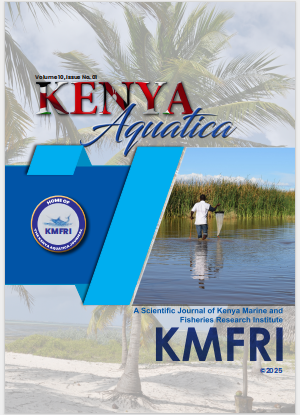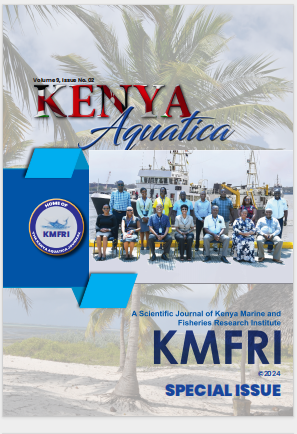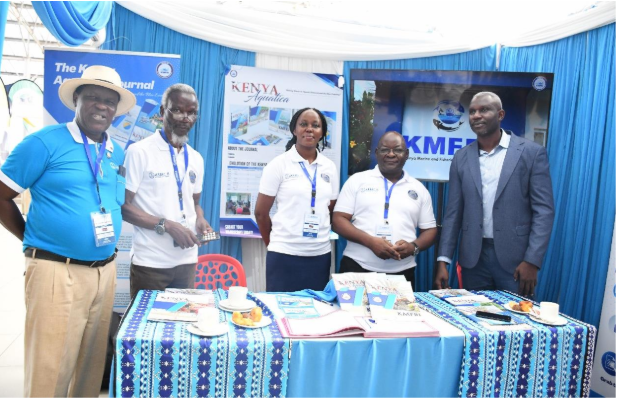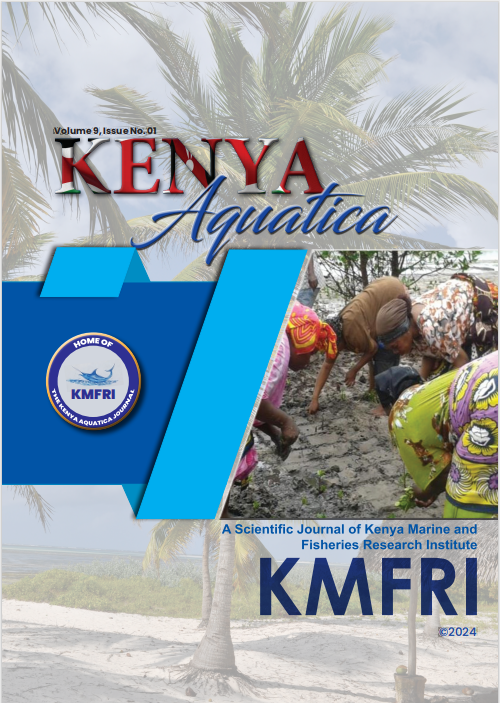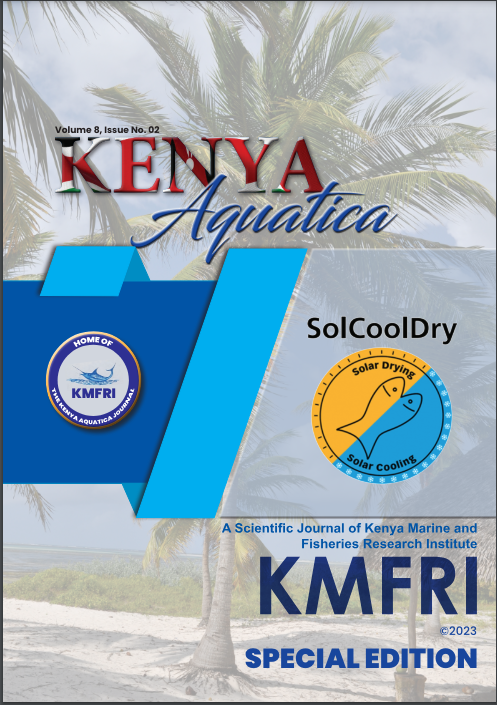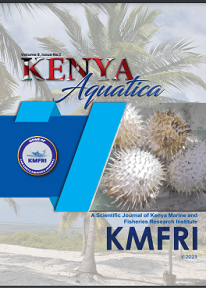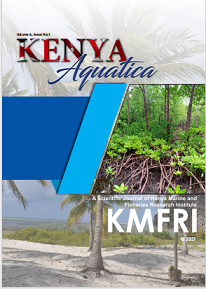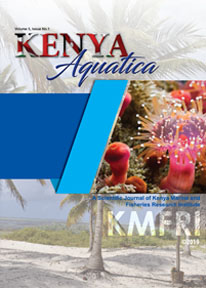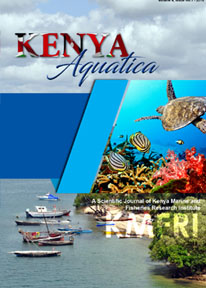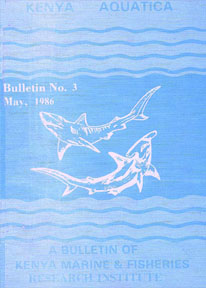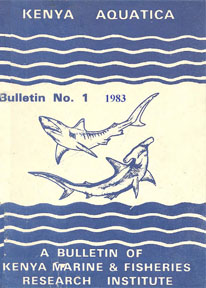Kenya Aquatica Journal
Vol 10 Issue 1 Contributors
- Nyakeya K et al.
- Mrombo NL et al.
- Mugo J et al.
- Mutie E et al.
- Obiero M et al.
- Odoli CO et al.
- Otuo PW et al.
- Wacira TN et al. (a)
- Wacira TN et al (b)
- Waithaka E. et al.
- Aura CM et al.
Distribution of organochlorine pesticides in macroinvertebrate functional feeding guild (FFG) of predators, Rhagovelia spp. in a tropical estuarine ecosystem
The current world population stands at approximately 8.5 billion people and this number is likely to shoot up in the coming decades. This increaing trend in world population demands the provision of sufficient food, which calls for improved agricultural production systems. In order to achieve this, a tremendous increase in pesticide application of about 30-40% has been documented and this trend is predicted to increase in the coming years. Due to their negative impacts to the environment, some pesticides mainly organochlorine pesticides (OCPs) have since been banned, but their residues can still be detected in different media causing deleterious effects on organisms.
Results revealed severe hypoxia (dissolved oxygen [DO] < 2.5 mg L-1), far below the 6–8 mg L-1 threshold required for fish survival, alongside hyper-eutrophic conditions marked by elevated ammonium (NH4
+ > 1.5 mg L-1), total nitrogen (TN > 40–50 µg L-1), and phosphorus (TP >700 µg L-1). Chlorophyll-a concentrations exceeded 100 µg L-1, indicating prolific algal blooms linked to nutrient overloading, possibly from industrial effluents, agricultural runoff, and untreated sewage.
Catch and effort composition and management implications of Lake Baringo’s small scale fishery
Small scale fisheries in Africa especially within the tropics are an important source of livelihoods to millions of people who depend on the fish value chain for employment. The fishing sector plays an important role in food security by provision of essential minerals and proteins. However, with increased population growth rate, there has been a rapid demand for fish in most of the inland lakes in Kenya, including Lake Baringo. This has led to increased exploitation of the fishery resources as the fishers’ target to maximize benefits. In order to come up with sound management of this resource, catch and effort data was collected through standard operating procedures for fish catch assessment survey (CAS). This was done in 6 landing beaches of Lake Baringo in 2024 by means of questionnaires and personal observations.
The Blue Economy, which encompasses sustainable use of aquatic resources for economic growth, improved livelihoods, and environmental health, has gained global recognition as a critical driver of sustainable development. Socio-economic studies play a fundamental role in enhancing the Blue Economy by providing insights into human interactions with marine and freshwater ecosystems, economic dependencies, and social dynamics that influence sustainable resource utilization. This paper highlights the critical role of socio-economic studies in shaping a sustainable and inclusive Blue Economy. This is because, these studies help in assessing the economic value of marine industries such as fisheries, tourism, and maritime transport, while identifying socio-economic challenges such as poverty, resource conflicts, and policy gaps.
species.
Special Edition
This Special Edition demonstrates that beyond infrastructure, KMFRI’s human resource capacity is a testament to its scientific prowess. The Institution has a dedicated workforce of 57 research scientists specializing in the coastal and marine science. Notably, over half of these scientists hold Doctoral qualifications, while nearly all others possess Master’s degrees. With research specialization spanning over 70 disciplines, KMFRI’s intellectual resource is complemented by 35 technologists and 105 support staff in the coastal and marine stations. This results in an exceptional researcher-to-support staff ratio of 1:4—an enviable metric not only in the region but also on a continental and global scale.
KENYA AQUATICA JOURNAL AT ARBEC II (2024) HELD IN KISUMU, KENYA
Volume 9 Contibutors
- Ontomwa et al
- Ochiel et al
- Waiyaki et al
- Aura et al
- Bironga et al
- Kyule et al
- Mokua et al
- Mrabu et al
Stock status of the dash-and-dot goatfish, Parupeneus barberinus (Lacepède, 1801) in Kenya’s coastal marine waters
Abstract
Demersal reef fisheries are important for the provision of food and livelihoods for the coastal communities. The fisheries are multispecies, exploited by artisanal fishers using a diverse range of gear types. Data collated from artisanal fishers along the Kenya coastline for the period 2017 to 2023 was used to assess the stock status of Parupeneus barberinus to inform the management of the fishery....
Abstract
Abstract
The proliferation of cages in the Great Lakes of Africa is accompanied by the potential socio-economic outcomes which underscores a significant trend in the aquaculture industry that is supplementing the traditional fisheries production. In light of these considerations, the study herein was undertaken to comprehensively evaluate the potential impacts of high intensity of cages at a site in Lake Victoria, Kenya with the leading numerical focus
Abstract
Abstract
The effect of replacing fish meal for black soldier fly larvae meal (BSFLM) on growth and feed utilization of African catfish (Clarias gariepinus) was evaluated in earthen ponds at Sagana research Centre. 240 fish were distributed in a completely randomized design with four treatments in triplicates. Fish were fed increasing inclusion levels of BSFLM replacing fish meal (FM) at 0%, 33%, 66%, and 100 designated as D1, D2, D3 and D4 respectively.
Abstract
Abstract
Special Edition
Community involvement in this technology through a tripartite collaboration with partner institutions from three key sectors comprising research, academia and industrial development will ensure sustainability of the SolCoolDry approach. Furthermore, it promises to be long lasting, with options for replicability along the Kenya coast and in other localities nationally, where aquatic systems comprising lakes, rivers and big dams exist.
Volume 8 Issue 1 Contibutors
A preliminary assessment of the post-harvest fish losses along selected fish supply chains in Kwale County, Kenya
Abstract
Artisanal marine fisheries play a critical role in enhancing food security and supporting the livelihoods of Coastal communities in Kenya. The sustainable exploitation of this resource is however threatened by post-harvest fish losses (PHFLs) occurring along the entire fish value chain.We conducted an assessment of the PHFLs at five landing sites in Kwale County to investigate the status of these losses along selected fish supply chains in the County.
Rapid assessment of the Indian mackerel Rastrelliger kanagurta fishery in Kenya’s coastal waters
AbstractThe Indian mackerel, Rastrelliger kanagurta is a highly migratory epipelagic species in the family Scombridae. The species plays a significant role in supporting the food security and livelihoods of coastal communities in the Western Indian Ocean. The exploitation status of R. kanagurta in Kenya’s waters is uncertain. This study evaluated the R. kanagurta fishery using available catch data collected from 2014-2015 and 2017-2020. The study described the catch dynamics and utilized a suite of length-based approaches to derive diagnostic indicators of the exploitation status.
Limnological status of Lake Oloidien in Kenya’s Rift Valley between 2020 and 2021
Water samples were collected between August 2020 and March 2021 and analyzed for physicochemical parameters to ascertain the current limnological status of Lake Oloidien. The maximum mean depth of the lake recorded was 7.7 m in November, which corresponded with a high water transparency value (69.0 ± 3.4 cm) in the same month. There were no significant variations in temperatures among the sampled stations, mean ranges were 23.15 ± 1.15°C and 23.93 ± 1.09°C.
Abstract
Aquaculture as an enterprise is hampered by the high cost of fish-based protein diets which account for 30 - 70% of the production cost. Alternative plant-based protein diets are paramount in guiding fish farmers on feed efficacy and fish stocking densities. This study analyzed the growth performance of marine acclimatized Nile tilapia (Oreochromis niloticus) using fish meal (animal protein), soybean (plant protein) and wheat bran (control) formulated diets. Nile tilapia fingerlings weighing 13 -17 g were cultured in hapa nets in three concrete-based ponds at stocking densities of 15 fish/m3, 10 fish/m3 and 5 fish/m3 for each feed treatment.
The potential of three culture techniques to mitigate environmental challenges and enhance yields of Eucheumoids (Rhodophyta; Gigartinales) in deep water on the Kenyan Coast
AbstractRelocation of seaweed farms from shallow to deeper waters has been recommended to remedy seasonal infestation of seaweeds by ice-ice disease and epiphytes. However, data supporting the best culture technique for farmers’ adoption is scarce. In the present study, the production potentials of one shallow, fixed off-bottom (FB) and two deep water techniques; modified off-bottom (MB) and floating raft (FR) techniques were evaluated by comparing the yields of Eucheumadenticulatum and Kappaphycus alvarezii while monitoring the environmental factors.
COVID-19 Ripples: Vulnerability to food insecurity and coping strategies for low-income fisheries-dependent lacustrine urban dwellers
AbstractThe Coronavirus disease (COVID-19) measures were counter-productive in the food and nutritional security landscape for households that were already vulnerable before the pandemic. Our study assessed the food insecurity experiences of low-income, fisheries-dependent, urban dwellers of Manyatta slum in Kisumu, Kenya, during the implementation of the COVID-19 regulations. Data was collected from 24 households in July 2021 for a period of 14 days using a standard food security assessment questionnaire
Alarming incidence of porcupinefish bycatch in the Lamu seascape beach seine fishery: Could this be a sign of an ecosystem imbalance?
AbstractOverfishing and destructive fishing practices are strongly associated with loss of biodiversity and habitat degradation resulting in the proliferation of non-target and resilient species. In the longterm, this may also lead to an ecosystem imbalance. This short communication documents a worrying trend of high catch ratios of porcupinefish in the Lamu seascape beach seine fishery observed during catch assessment surveys conducted in 2021 – 2023. The increasing incidence high puffer bycatch is alarming fishers due to concerns over economic loss.
Impact of COVID-19
Unmasking the impact of COVID-19 on the livelihoods of small-scale fishers along the Kenyan coast for possible interventions
Abstract
COVID-19 pandemic caused many human deaths and was a multiplier of vulnerability for many households. Consequently, threatening attainment of food security especially in developing countries. This research survey examined the socio-economic impact of COVID-19 on the lives of small-scale fishers associated with restrictions imposed in response to the pandemic among Kenya’s coastal fishing communities. The survey was undertaken through interviews of stakeholders in major fishing areas of Lamu, Malindi and Shimoni, which are the richest inshore fishing grounds with high concentration of artisanal fishers.
Restoring a Degraded Reef
Low-Tech, Community-Accessible Method to Restore a Degraded Reef, in Wasini Island, Kenya
Abstract
Coral reefs are among most diverse and productive ecosystems on earth; providing essential services such as supporting fisheries and tourism sectors, thereby contributing to food security, job creation, and economic development. However, around the world coral reefs are in decline and degraded state due to a combination of human and natural factors. Coral reef restoration is seen a tool that can be used to return the dying reefs and increase their resiliency Techniques for active restoration using coral farming and transplantation on artificial reef structures have been well developed and
proved to be viable for reef rehabilitation of degraded reefs, yet are rarely practiced. A pilot lowtech, community-accessible reef restoration project was implemented in Wasini community managed area, Kenya. The aim was to rehabilitate degraded reef areas using artificial reef structures. Here, we describe the steps involved in coral rehabilitation and the resulting outcomes.
Conference proceedings of the Kenya Coastal Development Project (KCDP)
Potential of Vetiver Grass (Chrysopogon zizanioides) in Phytoremediation of Kipevu Wastewaters
Abstract
Wastewater treatment worldwide has mainly been done using physical, chemical and biological treatment systems such as activated sludge and biological nutrient removal technologies. Mombasa produces large amounts of pollutant-laden effluent water that is collected and primarily treated and discharged into the Indian Ocean. Various pollutants such as nitrates, phosphates, zinc and cadmium in water bodies pose a threat to the aquatic species. The aim of this study was to explore
the potential of vetiver grass as a phytoremediation technology to minimise pollutants in water bodies. Field experiments were carried out using plastic containers of five litres which were set-up simultaneously with planted grass hydroponically. Wastewater was characterized for physicochemical parameters before and after treatment with the grass.
Access to Water in Kenya’s Coast Region
A Challenge to Community Development and Poverty Alleviation in Lamu County
Abstract
Water is considered a basic commodity and essential for life - living on planet earth is dependent on it. However, access to water has been and will continue to be a dilemma for a majority of the residents at the coast of Kenya. A close look at the window on “Coastal Resources and People” reveals that water is a key resource but despite its immense importance, many people especially in the rural areas and among the Vulnerable and Marginalized Groups (VMG’s) do not have adequate access to potable, reliable and convenient sources of water. Lamu, currently considered among water scarce counties in Kenya as per the Lamu County Integrated Development Plan (http://lamu.go.ke/wp content/uploads/2016/03/LAMU_CIDP-Revised.June_2014-1.pdf), faces serious challenge of provision of potable water to its residents
Marine Botanical Resources of Kenya Coast
Investigations have shown that the Kenyan cooast botanical resources are underutilized and have not been realized as exploitable resources. Aaprt from the mangroves which are heavily exploited, algae and marine angiospre resources are the least exploited. In a steo to realize these as future exploitable resources their current uses in kenya and how they could be used is discussed. Aview of research work which could be seen as a prelude to further research is also included.
The national objectives as a basis for working out research requirements and priorities
In the modern world, research consstitutes a powerful instrument for accelerating the pace of development and no nation can afford to neglect it. Research and experimental development (R& D) are being made to serve in an ever increasing degree and socioeconomiic needs of society and human welfare in its various aspects.
The present inadequacy of information for developmental purpose has highlighted the vital role of research and the need to orient it to serve developmental objectives. The question of identification of problems and assigning of priority then become a national concern which should be related to the resource endowments and the overall national perspectives.

